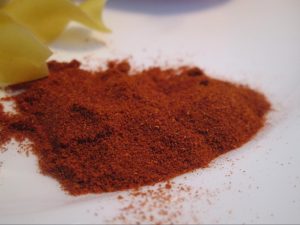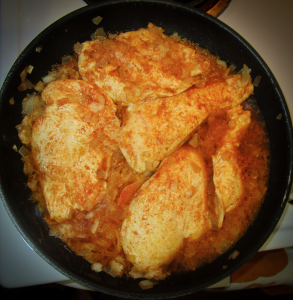Paprikas Csirke (Paprika Chicken)
By Sarah Rosenthal • December 13, 2018
Nearly ten years ago, my mom recorded and compiled recipes from both sides of our family into a cookbook, a copy of which each member of my family now stores lovingly within easy reach of his or her stovetop. The recipes in it come from a variety of cuisines, eras, and evolutions, strands of which have been woven in from the cultural heritage and experiences of my family members.
The week before I moved to Tuscaloosa for college, I opened my mom’s original binder-bound copy of the cookbook and flipped through laminated pages sticky from sauce-soaked fingers, flinging dried crumbs of mandelbrot all over the counter. I copied some of my favorite recipes down, because I anticipated the homesickness I’d soon encounter–the type which can only be cured by a family-famous meal.
When I came across our family’s recipe for chicken paprikash, I was delighted to see my mom’s margin note, which described how my great aunt passed down the recipe to her daughter over the phone as one of the first meals she cooked in her own apartment. It was the simple version of chicken paprikash–just chicken, butter, paprika, and onion, cooked together in the oven at 350º. However, it was comforting to know that a recipe that was so familiar to me and so important to my family’s roots was something I would be able to cook myself.
Chicken paprikash is one of Hungary’s national dishes; my great, great grandparents who immigrated to America from Hungary likely wouldn’t have made the simplified version of the recipe I had grown to love as a child, and instead would have made something similar to George Lang’s well-researched recipe for paprikas csirke, complete with homemade dumplings and a thick smear of sour cream. Chicken paprikash puts the full-bodied and sweet flavors of Hungarian paprika on full display. For this recipe, I’ve tried to get the best of both worlds–the ease of my family’s recipe with the unique depth of the historically authentic one. After trying it, you’ll understand why eating chicken paprikash is the closest thing to the comforting warmth of a hug from your mom when you’re away from home, even if you’re not Hungarian.
Process
First, you’ll want to purchase your ingredients. Hungarian dishes feature simple ingredients which are easy to find; you should never have trouble finding any produce or meat ingredients, and substitutions for many ingredients are okay as well. For example, you may choose to use canned tomatoes rather than a fresh one in this recipe to avoid the painstaking process of peeling the skin off the tomato. I’ve even amended the original recipe myself by substituting chicken cutlets for a whole chicken and butter for lard. However, you will want to purchase Hungarian or Hungarian-style sweet paprika to use in all Hungarian dishes, especially chicken paprikash.

Do not substitute Spanish or basic paprika in this recipe. Spanish paprika will make the dish unnecessarily smoky, and basic paprika will dull the flavors you will be working so hard to amplify.

You likely won’t be able to find Hungarian paprika at your normal grocery store. World Market carries it regularly, or you can order it online. If you have a specialty grocery store near you, you may be able to find it there as well.
Now, let’s cook!
First, you’ll want to prepare your ingredients. Chop your onions finely, and cut your butter into small pats for quicker melting. Place both in your large and deep sauté pan or Dutch oven and turn your stove burner to low heat. While you’re waiting for the onions to cook, prepare your chicken and peel and quarter your tomato.
When you notice the onions start to smell buttery and aromatic, begin to watch them closely–you want them to be soft and translucent, but not browned. This should take about 5 minutes.

When the onions look like the above photo, add your chicken and tomato pieces to the pan. Cover the pan and increase the heat slightly to medium-low. Set a timer for ten minutes. Meanwhile, measure out a heaping tablespoon of Hungarian paprika, a teaspoon of salt, and approximately ⅓ cup of water. Mix together until combined and set aside.

When the timer goes off, the chicken should look like the above photo ― just starting to cook through. Reduce the heat to very low. When the onions stop bubbling, add in the paprika mixture. It is crucial that the pan has cooled to a very low heat before you add the paprika–it will drastically alter the flavor of the dish if you burn the paprika by adding it to a very hot pan. Continue cooking on a very low heat for about 20 minutes.

When chicken looks cooked through (see photo above), remove the lid and stir. Continue cooking on a very low heat with the lid off for approximately ten more minutes to allow some of the liquid to evaporate. If all of the liquid evaporates, add more water a few tablespoons at a time. Do not allow the pan to get completely dry.

Approximately ten minutes after removing the lid, remove the chicken from the pan and set it aside. In a separate ramekin or small bowl, mix the flour, sour cream, and one teaspoon of cold water into a thick paste. Add the sour cream paste into the pan, and while still on low heat, slowly stir to incorporate it into the paprika sauce until it is very smooth. When you stop stirring, the sauce should have an oily sheen on top that glistens in the light.
Slice your green pepper and add it to the sauce, along with the reserved chicken and salt to taste. Cover the pot, and on a very low heat, cook for approximately 15 more minutes. To test doneness, pierce a pepper slice with a fork. When it pierces easily with little resistance and without a crunching sound, the dish is done cooking. Just before serving, stir in the heavy cream to turn the sauce into a light orange gravy.

To serve, spoon egg noodles onto a plate and top with a piece of chicken. Then, spoon the gravy sauce generously over the dish. You may choose to do as the Hungarians do by swiping the top of the chicken with a dollop of sour cream to finish the plate, and enjoy!
Abbreviated Recipe
Paprikas Csirke (Chicken Paprikash); Adapted from George Lang’s The Cuisine of Hungary
Preparation Time: approximately 1.5 hours
Yield: 4-6 servings
Ingredients:
- 2 medium-sized onions, peeled and minced
- 2.5 tablespoons butter
- About 2.5 pounds of chicken breasts or cutlets
- 1 large ripe tomato, peeled and cut into quarters
- 1 heaping tablespoon Hungarian-style paprika
- 1 teaspoon salt
- 1 green pepper, sliced into strips
- 2 tablespoons sour cream
- 1 tablespoon flour
- 2 tablespoons heavy cream
- Wide egg noodles, for accompaniment
Instructions:
- In a 4 or 5 quart Dutch oven or deep sauté pan, cook onions in butter over low heat until fragrant and translucent but not browned, about 5 minutes.
- Add chicken and tomato, cover, and cook on medium-low heat for about 10 minutes.
- Reduce heat to very low, and when onions have stopped bubbling, stir in paprika, 1/3 cup water, and salt. Cook, covered, on very low heat, for approximately 20 minutes. When chicken seems cooked through, remove the lid and cook for 10 more minutes to let some of the liquid evaporate. If all of the liquid evaporates, add several more tablespoons of water so that the pan is not completely dry.
- Remove the chicken from the pot and set aside. Mix the sour cream, flour, and 1 teaspoon of cold water into a thick paste. With the stove still on low heat, slowly stir the sour cream paste into the sauce in the pan until it’s very smooth. When you stop stirring, the sauce should reveal a glistening, oily sheen on top.
- Add green pepper, reserved chicken, and add salt to taste. Cover the pot and cook over very low heat until peppers are soft and pierce easily with a fork without a crunching sound, about fifteen minutes.
- Just before serving, stir in the heavy cream to make the sauce into a light orange gravy.
- Serve over wide egg noodles, and spread a dollop of sour cream on top of plated chicken for a true Hungarian flair.